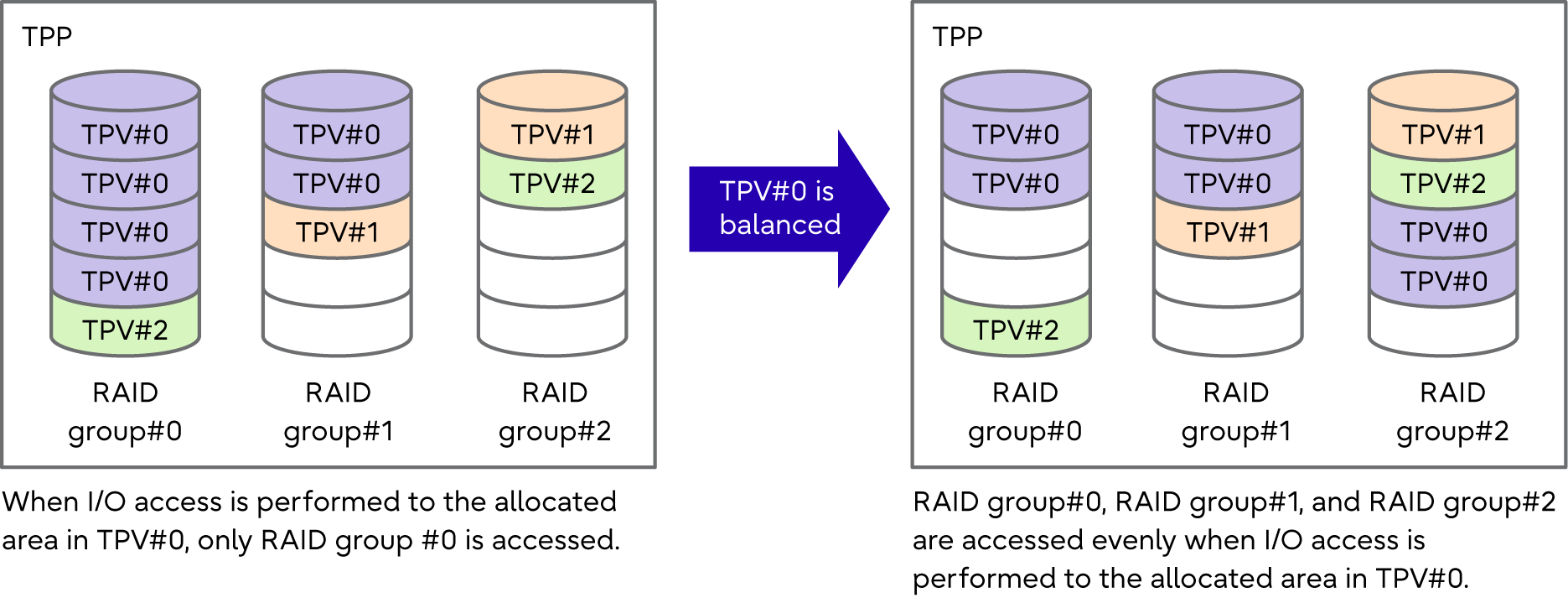TPV Balancing
A drive is allocated when a write is issued to a virtual volume (TPV). Depending on the order and the frequency of writes, more drives in a specific RAID group may be allocated disproportionately. Also, the physical capacity is unevenly allocated among the newly added RAID group and the existing RAID groups when physical drives are added to expand the capacity.
Balancing of TPVs can disperse the I/O access to virtual volumes among the RAID groups in the Thin Provisioning Pool (TPP).
- When allocating disproportionate TPV physical capacity evenlyFigure: TPV Balancing (When Allocating Disproportionate TPV Physical Capacity Evenly)

- When distributing host accesses evenly after TPP expansion (after drives are added)Figure: TPV Balancing (When Distributing Host Accesses Evenly after TPP Expansion)

Balance Thin Provisioning Volume is a function that evenly relocates the physically allocated capacity of TPVs among the RAID groups that configure the TPP.
Balancing TPV allocation can be performed for TPVs in the same TPP. TPV balancing cannot be performed at the same time as RAID Migration to a different TPP for which the target TPV does not belong.
When a write is issued to a virtual volume, a drive is allocated. When data is written to multiple TPVs in the TPP, physical areas are allocated by rotating the RAID groups that configure the TPP in the order that the TPVs were accessed. When using this method, depending on the write order or frequency, TPVs may be allocated unevenly to a specific RAID group. In addition, when the capacity of a TPP is expanded, the physical capacity is unevenly allocated among the newly added RAID group and the existing RAID groups.
Balancing Level
The TPV balance status is displayed by three levels; "High", "Middle", and "Low". "High" indicates that the physical capacity of TPV is allocated evenly in the RAID groups registered in the TPP. "Low" indicates that the physical capacity is allocated unequally to a specific RAID group in the TPP.
TPV balancing may not be available when other functions are being used in the ETERNUS DX or the target volume.
Refer to Combinations of Functions That Are Available for Simultaneous Executions for details on the functions that can be executed simultaneously, the number of simultaneous executions, and the capacity that can be processed concurrently.
When a TPP has RAID groups unavailable for the balancing due to lack of free space, etc., the physical allocation capacity is balanced among the remaining RAID groups within the TPP. In this case, the balancing level after the balancing is completed may not be "High".
By performing the TPV balancing, areas for working volumes (the migration destination TPVs with the same capacity as the migration source) are secured in the TPP to which the TPVs belong. If the maximum pool capacity of the ETERNUS DX has been exceeded by the total logical capacity of the TPVs in all the TPPs that include the working volumes, a TPV balancing cannot be performed.
In addition, this may cause a temporary alarm state ("Caution" or "Warning", which indicates that the threshold has been exceeded) in the TPP during a balancing execution. This alarm state is removed once balancing is completed successfully.
While TPV balancing is being performed, the balancing level may become lower than before balancing was performed if the capacity of the TPP to which the TPVs belong is expanded.



